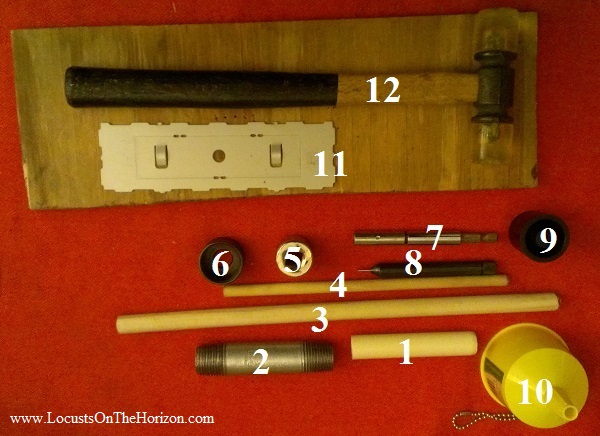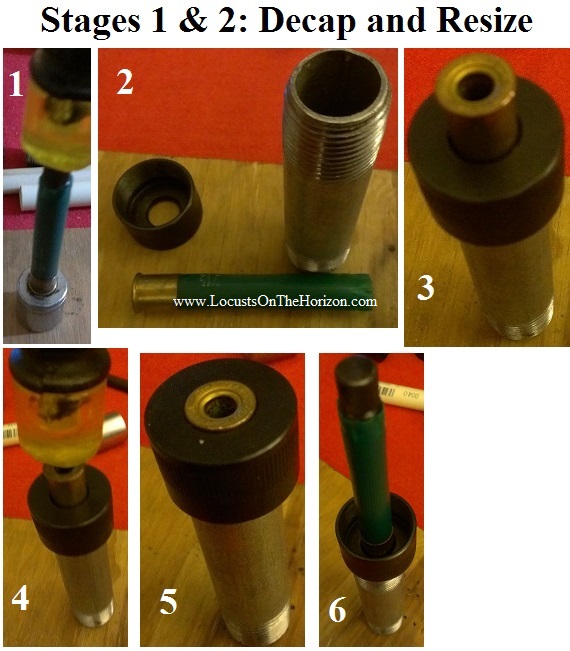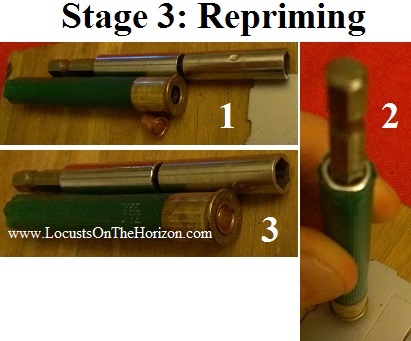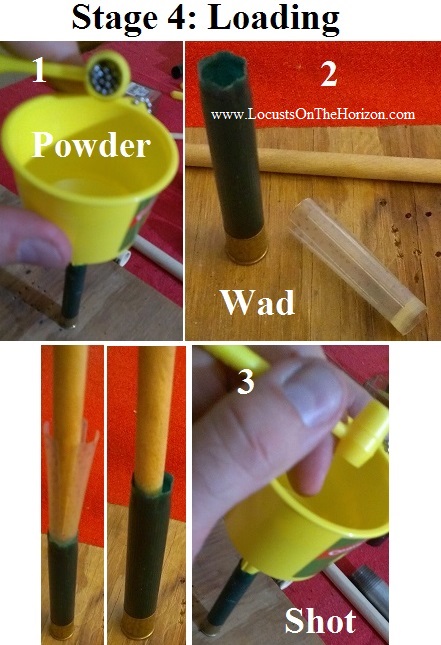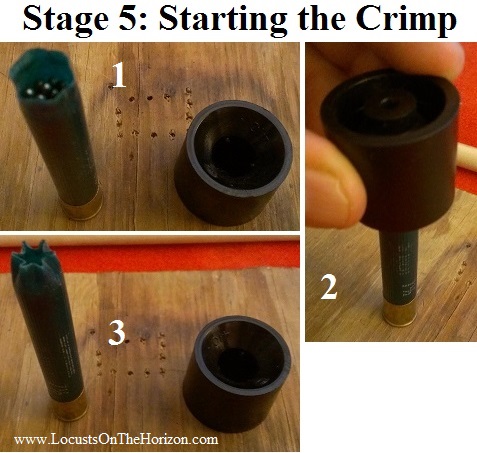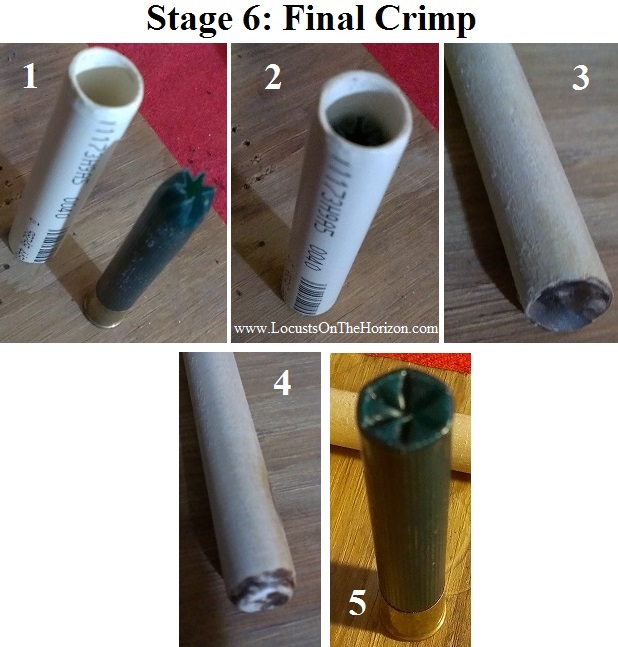By Plan B Writer’s Alliance – http://www.LocustsOnTheHorizon.com
(This article is adapted from the book ‘Locusts on the Horizon‘ from the chapter titled ‘Powder’. )
In our 1187 page, 247,000 word book, Locusts on the Horizon, we have a 409 page Defense section where we go into depth about all aspects of firearms, including selection, history, reloading, home powder manufacture, bullet casting, real world terminal ballistics of common calibers, and many other topics.
AN UNCERTAIN SUPPLY CHAIN
As we watch the world we grew up with getting more precarious and uncertain by the day, one thing that most preppers can accurately assume is that at some point, ammunition and reloading supplies stand a very high chance of becoming much harder to obtain. If things get bad enough, either by the halting of manufacture, or by oppressive government regulation, at some point people will have to improvise.
While weapons such as a crossbow, or a bow and arrow have their place in the grand scheme of things, there is still no substitute for firearms. Even the Native Americans, experts with the bow and arrow from childhood onwards, recognized this from the first moment they encountered firearms and they quickly did everything they could to upgrade.
The three expendable components of firearms ammunition that people will, at some point, have to start making their own fresh supplies of are an ignition source (primers, caps, flint), a power source (powder), and a projectile (bullets, shot, slugs). If there is anyone one of these you can and should horde a ridiculous amount of are primers, as they are the hardest to fabricate.
POWDERS
In this article we will be discussing the manufacture and use of homemade powder for use in firearms ammunition. There are two types of powder, traditional gunpowder, and ‘smokeless powder’.
For those who are new to this subject, traditional gunpowder is the old stuff, typically called ‘blackpowder’. This is a simple mix of saltpeter (potassium nitrate), sulfur, and charcoal. It’s an explosive mixture, and modern fire codes also consider it as such.
NOTE: Check zoning and fire codes for maximum legal amounts of smokeless powder and blackpowder you can have in a residential home. Blackpowder, being an explosive, usually has a more restrictive quantity limit than smokeless. Common sense dictates that you never store your powder next to your supply of primers, just as an added measure of safety.
The newer stuff is ‘smokeless powder’ (new as in 1890’s). Smokeless powder is not merely a mixture of components like blackpowder is. It is a chemical compound, a nitrocellulose based propellant, though highly combustible, is not actually classed as an explosive the way blackpowder is.
When compared to blackpowder, smokeless powder offers far less smoke, far less fouling, between two and three times the power (depending upon the powder brand), and subsequently higher velocities, in addition to much higher chamber pressures. While blackpowder is measured by volume, smokeless is carefully measured by weight.
Different blackpowders generally only vary in the fineness of the flake size (the corn size) and the quality of manufacture. Regardless of that, blackpowder is still just blackpowder, with the same ingredients in the same proportions.
Smokeless powders, however, are all different blends, each of which are formulated as per their intended use. Different smokeless powders are made specifically for pistol cartridges, others specifically for rifles, and others specifically for shotguns. Because shotguns and pistols are both low pressure types of rounds (a 12 gauge shotgun shell has about half the chamber pressure of a .22LR rimfire round), some smokeless powders are dual use, intended for use in either pistol or shotgun ammo.
In the interest of long term survival, one of the key differences between the two types of powder is that your average person can make blackpowder. In a pinch it can be made at home (preferably outside the dwelling).
Making smokeless powder is another matter altogether. In order to make smokeless powder properly, and without a high risk of killing those making it, you need someone who is a professional grade chemist with the proper equipment to support the operation.
NOTE: These days, blackpowder weapons are still in common use, and there are blackpowder substitutes available such as Pyrodex. However, that is irrelevant to the current discussion since Pyrodex and other blackpowder substitutes, while some ingredients are public knowledge, they all typically involve a proprietary formula, not an ancient, well known formula like blackpowder.
USING BLACKPOWER IN A MODERN FIREARM
Blackpowder was the fuel for muzzle loading weapons for centuries. Cartridges were loaded with blackpowder from around the end of the US Civil War up until the mid to late 1890’s, which was about 30 years.
So, can you use blackpowder in a modern weapon?
The general rule of thumb is that you should never use smokeless loads in a weapon designed for blackpowder loads. However, a modern firearm designed for smokeless powder can typically take almost any blackpowder load, provided that the blackpowder has been loaded properly into the cartridge. Modern weapons designed to use smokeless powder are designed to handle powder that has between two and three times the power of blackpowder.
Keep in mind, though, that blackpowder is extremely dirty and really leaves a lot of residue, plus it burns really hot and the pressures are typically lower than smokeless. Using blackpowder in a semi-auto like an AR-15 isn’t really a good idea. There is a good reason that auto-loading weapons really didn’t start to take off till after smokeless powder came out in the 1890’s. So, lever actions, pump actions, bolt actions, and break actions are probably your best bet if you have to start using blackpowder. For reliable use in handguns, revolvers are the handgun of choice when using blackpowder, not semi-automatics.
Something to always remember about using blackpowder in cartridges is that you cannot leave empty airspaces in the cartridge case. If you will notice, cartridges either designed in the blackpowder cartridge era, or were based upon cartridges from that era, tend to not have steep shoulders. They tend to either be straight walled or with gradually sloped shoulders. This makes them easier to properly load the case with blackpowder.
One very popular modern rifle cartridge that has a blackpowder cartridge in its ancestry is the .30-30 Winchester. The .30-30 was the very first purely smokeless cartridge sold in the USA (1895), and the .30-30’s “parent case” was an older blackpowder caliber. Two legacy handgun cartridges from the blackpowder era that are in common use today are the .38 Special and the .45 Colt, both of which were originally loaded at the factory with blackpowder. Some legacy rifle cartridges from the blackpowder era, originally loaded with blackpowder, which are still popular are the .45-70, the .303 British, and 7.62x54R.
One very common cartridge that is a hold-over from the blackpowder era is the 2-3/4” 12 gauge shotgun shell, which is probably the most common centerfire caliber in the USA. The length of the 2-3/4” 12 gauge shotgun shell itself is a direct legacy of the extra room needed for a charge of blackpowder (3” shells were not offered for sale in the USA till the 1930’s).
Because of the lower chamber pressures and velocities, the 12 gauge shotgun, and other gauges as well, are typically the one class of ‘modern’ cartridges where you really don’t lose much, if any, ballistic performance in most loads if you have to revert back to using blackpowder. This is provided, of course, that your powder is well made and you load the shell properly. Because blackpowder burns very hot, older plastic shells often wouldn’t last more than one or two uses with blackpowder, but the better plastic in most current shells does a much better job.
As we have stated, whether you use it in a muzzleloader or in a cartridge, blackpowder cannot be loose, such as what is often the case with smokeless. If you leave it loose, you can get a catastrophic failure. You fill the case, tamp it down, and you compress it a tad when you seat the bullet. One old time guide is to fill the case 1/16″ past the point where the bullet will seat and then compress the powder when it seats. With a shotgun shell, you tamp the powder charge down then seat the nitrocard or the plastic wad and tamp it into place.
Consult a reloading manual, of course, before you do any reloading. One of the benefits of the popularity of cowboy action shooting and blackpowder metallic cartridge shooting is that there is a lot of current, up to date knowledge floating around about reloading cartridges with blackpowder.
MAKING BLACKPOWDER
Making blackpowder yourself for use as gunpowder is not something we endorse and you do so at your own risk. You will also usually void all warranties on any firearm when you do this. Use common sense and caution. We give information on it for educational purposes only. In our opinion, making your own blackpowder is best left for times of extreme austerity or prolonged shortages of ammo on the retail market.
That said, the ability to manufacture blackpowder means people can retain the capability to hunt and defend themselves with firearms almost indefinitely.
The three main ingredients are potassium nitrate (saltpeter), charcoal, and sulfur. The formula for blackpowder is 75% potassium nitrate (5 parts), 15 % charcoal (one part), and 10% sulfur (2/3 of 1 Part). These percentages are percentages by weight, so you will need a scale. Most people probably won’t be making huge amounts, so a small, inexpensive digital scale will work. For best results, your measurements should be as precise as possible.
These ingredients are commonly available at hardware and garden stores like Home Depot and Lowes, and generally they are not that expensive. You can also often find the ingredients at your local pharmacy, such as ‘saltpeter’ and ‘flour of sulfur’.
For an example of garden department blackpowder making supplies, stump remover, such as the Spectracide brand, is generally about 99% pure potassium nitrate. Lilly Miller Garden Sulfur is 90% sulfur and 10% anti-caking agent.
Real hardwood charcoal, not charcoal briquettes, is best. Pound the charcoal to small bits, such as with a mortar and pestle, and then powder it. An electric coffee grinder or something similar generally works well for this.
One key step in the process that many people miss when making blackpowder is that they don’t mill it.
The speed at which a given batch of blackpowder burns is a good indicator of its quality. For use in a firearm, you want a powder that burns as fast as possible. You get this by milling.
When in loose, fine powder, like you find in a firecracker, blackpowder is in a form called ‘serpentine’. Milling is where, after mixing, the serpentine powder is put into a tumbler made of a non-sparking material with heavy, lead balls and tumbled for several hours. Home gunpowder makers often use an inexpensive, hobby grade rock tumbler for this.
Blackpowder is a mixture, not a chemical compound. Because of this, you need milling to press the ingredients together tightly. The longer the powder is milled, the tighter the ingredients in the mixture are pressed together, and the faster the mixture burns when ignited. You can pour out two lengths of powder, one milled and one not milled, and then light them off. You can see the difference in the burn rate.
After you mill the powder for about six hours, you need to add a binder to assist in the flaking/corning process. You calculate what 5% of the mass would be of the weighed ingredients you have in the powder mix, and you add that much ‘dextrin’ to the powder while it is still in the mill. You then mill the powder for about 20 more minutes with the dextrin in the mix.
Dextrin is made well in advance of any powder making by spreading ordinary corn starch out thin on a pan or a cookie sheet, and baking it at 400 degrees Fahrenheit for three hours.
After the milling is done, the next step is the corning/flaking process. Blackpowder is typically graded on how finely flaked it is. Homemade gunpowder on the frontier was often not ‘corned’ and was used in serpentine form. Serpentine, however, does not provide optimal performance.
For proper blackpowder intended for use in firearms, for the best performance it needs to be ‘corned’ (flaked). A common way this is done is to get the serpentine style gunpowder soaked in alcohol and then grated into granules on a screen over something to collect it, such as a piece of newspaper, then allowed to dry.
It can be then sifted and graded as to the flake size. Large ‘F’ would be for things like cannons, and finer flaked powder like ‘FFF’ would be for pistols. Often, homemade powder is just used without sorting out the different sized flakes.
It doesn’t take a huge amount of ingredients to make enough blackpowder to load quite a few shotgun shells and handgun cartridges. One simple batch can give you plenty for most self-defense needs and for hunting.
For example, a typical 2-3/4”, 12 gauge shotgun shell load will be a 3 dram blackpowder charge. A common blackpowder load for a .45 Colt used nowadays is 35 grains of blackpowder. Current blackpowder load data for .38 Special shows a load of 18 grains of blackpowder.
A one pound container of Spectracide stump remover sold at Home Depot is about $7.30, as of 2013. That one pound of stump remover is pretty much pure potassium nitrate and is 75% by weight of the blackpowder mix.
This means that one pound container of stump remover, when combined with the other blackpowder ingredients, including the extra 5% of dextrin, will make 22.4 ounces of blackpowder, or 358.4 drams. When measured in grains, at 7000 grains per pound, that would be 9800 grains of blackpowder.
So, that one pound of stump remover should produce enough homemade blackpowder to reload 119, general purpose, 12 gauge 2-3/4” shotgun shells with a 3 dram charge. It can also reload 280 rounds of .45 Colt ammo, or 544 rounds of .38 Special ammo.
If times are tough, that much ammo can make a significant difference between living and dying.
LINKS
One of the YouTube Channels which we like is from a man who goes by the name ‘Brushhippie’. Brushhippie makes his own corned blackpowder to use in his old fashioned firearms. He has a couple of good videos that shows his basic process and he makes some very fast powder. His process which he sets up outside is simple, portable, and practical. Before you attempt to make any blackpowder, watch his videos.
‘Making Blackpowder’ by Brushhippie
Part 1 http://www.youtube.com/watch?v=fKB8c4VLbw0
Part 2 http://www.youtube.com/watch?v=AUVo_hOadyc
© Plan B Writer’s Alliance – Permission to copy and reprint this article is given so long as reference to the original author and the website http://www.locustsonthehorizon.com are mentioned.


